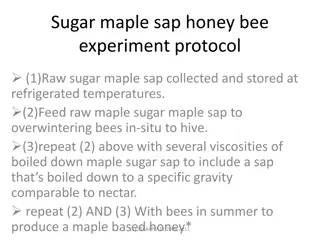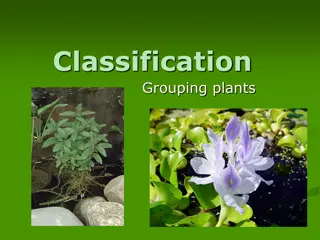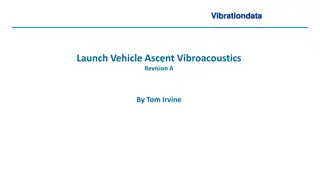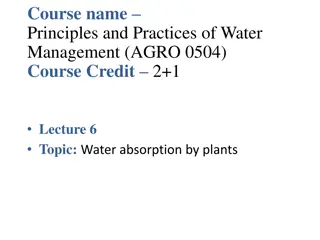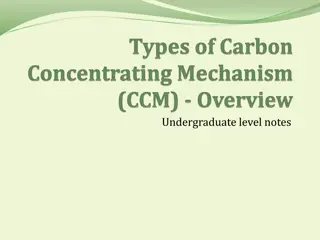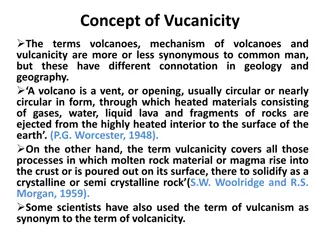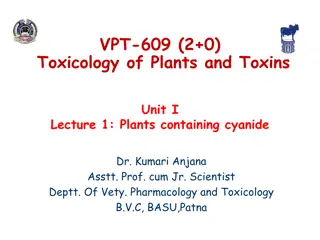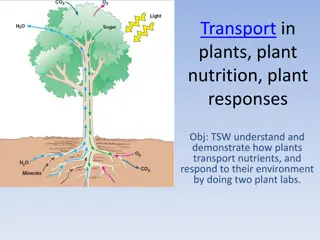Mechanisms of Sap Ascent in Plants Explained
Sap ascent in plants, primarily through xylem, is crucial for transporting water and nutrients. Theories such as vital force, root pressure, and cohesion tension attempt to explain this process, highlighting mechanisms like osmotic concentration and electro-osmotic potential. Root pressure theory proposes a positive pressure in xylem sap due to active water absorption. Objections to this theory exist, emphasizing the complex nature of sap ascent in plant physiology.
Download Presentation

Please find below an Image/Link to download the presentation.
The content on the website is provided AS IS for your information and personal use only. It may not be sold, licensed, or shared on other websites without obtaining consent from the author. Download presentation by click this link. If you encounter any issues during the download, it is possible that the publisher has removed the file from their server.
E N D
Presentation Transcript
Ascent of Sap Dr. Habibur Rahman Associate Professor J. N. College, Boko
Ascent of Sap Sap is water with dissolved ingredients (minerals). The upward movement of water from roots towards the tips of stem branches and their leaves is called ascent of sap. It occurs through the tracheary elements of xylem. That the ascent of sap occurs through xylem can be proved by stain test and ringing experiment.
Theories of Ascent of Sap: Water or sap is lifted from near the root tip to the shoot tip against the force of gravity, sometimes to height of 100 meters. The rate of translocation is 25-75 cm/minute (15- 45 m/hr). Several theories have been put forward to explain the mechanism of ascent of sap. The theories are vital force, root pressure, cohesion tension and theory of Capillarity 1. Vital Force Theory A common vital force theory about the ascent of sap was put forward by J.C. Bose (1923). It is called pulsation theory. The theory believes that the innermost cortical cells of the root absorb water from the outer side and pump the same into xylem channels. However, living cells do not seem to be involved in the ascent of sap as water continues to rise upward in the plant in which roots have been cut or the living cells of the stem are killed by poison and heat (Boucherie, 1840; Strasburger, 1891).
2. Root Pressure Theory: positive pressure that develops in the xylem sap of the root of some plants. It is a manifestation of active water absorption. Root pressure is observed in certain seasons which favours optimum metabolic activity and reduce transpiration. The theory was put forward by Priestley (1916). Root pressure is a spring in temperate habitats. The amount of root pressure commonly met in plants is 1-2 bars or atmospheres. Higher values (e.g., 5-10 atm.) are also observed occasionally. Root pressure is retarded or becomes absent under conditions of starvation, low temperature, drought and reduced availability of oxygen. There are three viewpoints about the mechanism of root pressure development- It is maximum during rainy season in the tropical countries and during
(i) Osmotic concentration causes withdrawal of water from the surrounding cells as well as from the normal pathway of water absorption. As a result a positive pressure develops in the sap of xylem. Tracheary elements of xylem accumulate salts and sugars. High solute (ii) Electro-osmotic A bioelectric potential exists between the xylem channels and surrounding cells which favours the passage of water into them. (iii) Nonosmotic Differentiating xylem elements produce hormones that function as metabolic sinks and cause movement of water towards them. The living cells surrounding xylem can actively pump water into them.
Objections to Root Pressure Theory: Root pressure has not been found in all plants. No or little root pressure has been seen in gymnosperms which have some of the tallest trees of the world. Root pressure is seen only during the most favourable periods of growth like spring or rainy season. At this time the xylem sap is strongly hypertonic to soil solution and transpiration rate is low. In summer when the water requirements are high, the root pressure is generally absent. The normally observed root pressure is generally low which is unable to raise the sap to the top of trees. Water continues to rise upwards even in the absence of roots. The rapidly transpiring plants do not show any root pressure. Instead a negative pressure is observed in most of the plants. Root pressure is generally observed at night when evapotranspiration is low. It may be helpful in re-establishing continuous water chains in xylem which often break under enormous tension created by transpiration.
3. Physical Force Theories: These theories consider dead cells of xylem responsible for ascent of sap. Capillary theory of Boehm 1863, Imbibition Theory of Unger 1868 and Cohesion-Tension Theory of Dixon and Joly 1894 are few physical theories. But cohesion-tension theory (also called cohesion-tension transpiration pull theory) of Dixon and Joly is most widely accepted one. Cohesion Tension Theory (Cohesion-Tension and Transpiration Pull Theory) improved by Dixon in 1914. Therefore, the theory is also named after him as Dixon s theory of ascent of sap. Today most of the workers believe in this theory. The theory was put forward by Dixon and Joly in 1894. It was further
The main features of the theory are: (a)Continuous Water Column: and into the leaves. The water column is present in tracheary elements. The latter do operate separately but form a continuous system through their un- thickened areas. Since there are a large number of tracheary elements running together, the blockage of one or a few of them does not cause any breakage in the continuity of water column. The column of water does not fall down under the impact of gravity because forces of transpiration provide both energy and necessary pull. Cohesion, adhesion and surface tension keep the water in place. There is a continuous column of water from root through the stem
(b)Cohesion or Tensile Strength: of attraction called cohesion force. The mutual attraction is due to hydrogen bonds formed amongst adjacent water molecules. On account of cohesion force, the water column can bear a tension or pull of up to 100 atm. Therefore, the cohesion force is also called tensile strength. Its theoretical value is about 15000 atm but the measured value inside the tracheary elements ranges between 45 atm to 207 atm. Water column does not further break its connection from the tracheary elements (vessels and tracheids) because of another force called adhesion force between their walls and water molecules. Water molecules are attracted to one another more than the water molecules in the gaseous state. It produces surface tension that accounts for high capillarity through tracheids and vessels Water molecules remain attached to one another by a strong mutual force
(c)Development of Tension or Transpiration Pull: Intercellular spaces present amongst mesophyll cells of the leaves are always saturated with water vapours. The latter come from the wet walls of mesophyll cells. The intercellular spaces of mesophyll are connected to the outside air through stomata. Outside air is seldom saturated with water vapours. It has a lower water potential than the moist air present inside the leaf. mesophyll cells continue to lose water to the intercellular spaces. As a result curvature of meniscus holding water increases resulting in increase in surface tension and decrease in water potential, sometimes to -30 bars. The mesophyll cells withdraw water from the deeper cells as its molecules are held together by hydrogen bonds. Therefore, water vapours diffuse out of the leaves. The
The deeper cells in turn obtain water from the tracheary elements. The water in the tracheary elements would, therefore, come under tension. A similar tension is felt in millions of tracheary elements lying adjacent to the transpiring cells. It causes the whole water column of the plant to come under tension. As the tension develops due to transpiration, it is also called transpiration pull. On account of tension created by transpiration, the water column of the plant is pulled up passively from below to the top of the plant like a rope. about 10 metres, a tension of 10-20 atm is sufficient to raise water to the height of the tallest tree over 130 m. It overcomes, (i) gravitational pull, (ii) resistance of narrow xylem channels and their end walls, (iii) resistance of living cells of the root that lie in the path of water from soil to xylem, (iv) resistance offered by water coming out of narrow capillary pores of the soil. As a tension of one atmosphere is sufficient to pull water to a height of
Evidences: (i)The rate of water absorption and hence ascent of sap closely follows the rate of transpiration, (ii)Evaporation of water from a porous pot or atmometer can produce a tension in the water column present in attached tube. It can even raise a column of mercury to sufficient height . (iii)Shoot attached to a tube having water and dipping in a beaker having mercury can cause the movement of mercury into the tube showing transpiration pull (iv)In a branch cut from a rapidly transpiring plant, water snaps away from the cut end showing that the water column is under tension, (v)With the help of dendrograph it is found that tree trunks contract during the day time and expand during the night. Contraction is caused by narrowing of tracheary elements when the contained water is under tension,
(vi)The maximum tension observed in water column is 10-20 atm. It is sufficient to pull the water to the top of the tallest trees of even more than 130 metres in height. The tension cannot break the continuity of water column as cohesive force of xylem sap is 45 to 207 atm. (vii)Gymnosperms are at a disadvantage in the ascent of sap because of the presence of tracheids instead of vessels in angiosperms. However, tracheidal xylem is less prone to gravitation under tension. Therefore, most of the tall trees of the world are redwoods and conifers.
4.Theory of Capillarity: Water rises in tubes of small diameter, kept in vessel having water, due to force of surface tension or adhesion and cohesion. Water similarly rises up in the walls of xylem channels due to adhesion. Cohesive force present amongst water molecules pulls the water upwards through the xylem channels. The upward movement will continue till the forces of adhesion and cohesion are balanced by the downward pull of gravity.
Objections to Theory of Capillarity: (i) The value of capillarity is very small. It can raise water to a height of about 1 metre in vessels of normal diameter (0.03 mm). Therefore, if operational it will be useful to only small sized paints, (ii) Capillarity occurs only when base of the tube dips in container having water. Xylem vessels are not directly connected with soil water, (iii) Rise due to capillarity will increase when the lumen of vessels is less. Tall plants should, therefore, have narrow vessels as compared to smaller plants. The truth is, however, reverse, (iv)Capillarity cannot operate in plants having tracheids due to the presence of end walls.
Cavitation: filled cavities in liquids in motion in a region where the pressure of the liquid falls below its vapour pressure. Cavitation occurs in xylem of vascular plants when the tension of water within the xylem becomes so high that dissolved air within water expands to fill either the vessels or the tracheids. The blocking of a xylem vessel or tracheid by an air bubble or cavity is called as embolism (Gr. embolus, stopper), and such a vessel or tracheid is said to be embolized. In scientific literature however, both cavitation and embolism are very often treated as one and the same. Cavitation (L. Cavus, hollow) is the phenomenon of gas or vapour
QUESTIONS: 1. Write an account on ascent of sap in plants. 2. Explain in detail the transpiration pull & cohesion of water theory of Ascent of sap. 3. Can the ascent of sap occur in trees by root pressure only? Explain. 4. Explain the mechanism of ascent of sap in plants. 5. What is Embolism? Does it affect water transport in plants? Write short notes on: a. Transpiration pull b. Vital theories of Ascent of Sap c. Xylem cavitation



